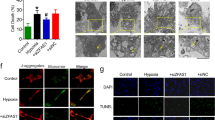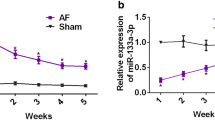Abstract
Long non-coding RNA (lncRNA) plays a pivotal role in the development of myocardial infarction (MI). The aim of this study was to investigate the effects of lncRNA actin filament-associated protein 1 antisense RNA 1 (AFAP1-AS1) on cell cycle, proliferation, and apoptosis. RT-qPCR was used to detect the expression levels of AFAP1-AS1, miR-512-3p, and reticulon 3 (RTN3) in rat model of I/R. The simulated MI environment was constructed. MTT assay and flow cytometry were used to detect changes in cardiomyocyte viability and cell cycle/apoptosis after MI by AFAP1-AS1 silencing or RTN3 silencing. The targeting relationship of miR-512-3p and AFAP1-AS1 and RTN3 in cardiomyocytes was verified by dual luciferase reporter assay. The expression levels of AFAP1-AS1 and RTN3 were significantly upregulated in a rat model of LAD ligation (or MI) ligation, while the expression level of miR-512-3p was significantly reduced. Overexpressed AFAP1-AS1 and RTN3 promoted cardiomyocyte apoptosis and inhibited cardiomyocyte proliferation. MiR-512-3p was a direct target of AFAP1-AS1, and RTN3 was a direct target of miR-512-3p. AFAP1-AS1 promoted the progression of MI by targeting miR-512-3p. AFAP1-AS1 promoted the progression of MI by modulating the miR-512-3p/RTN3 axis. AFAP1-AS1 may be a potential therapy target for MI.

The role of AFAP1-AS1 in regulating MI injury in vivo. (A) Effect of AFAP1-AS1 in MI injury in vivo. (B) The mRNA level of RTN3 in MI injury in vivo. (C) The protein level of RTN3 in MI injury in vivo. (D) Effect of miR-512-3p in MI model group. (E) TUNEL assay. *P < 0.05, **P < 0.01 vs the sham group; #P < 0.05, ##P < 0.01 vs the MI group







Similar content being viewed by others
Abbreviations
- RTN3:
-
Reticulon 3
- lncRNAs:
-
Long non-coding RNAs
- MI:
-
Myocardial infarction
- miRNA:
-
microRNA
- DMEM:
-
Dulbecco’s modified Eagle’s medium
- FBS:
-
Fetal bovine serum
- qRT-PCR:
-
Quantitative reverse transcription PCR
References
Afanasiev, S. A., Garganeeva, A. A., Kuzheleva, E. A., Andriyanova, A. V., Kondratieva, D. S., & Popov, S. V. (2018). The impact of type 2 diabetes mellitus on long-term prognosis in patients of different ages with myocardial infarction. Journal Diabetes Research, 2018, 1780683. https://doi.org/10.1155/2018/1780683.
Ahmed MS, Jadhav AB, Hassan A, Meng QH (2012) Acute phase reactants as novel predictors of cardiovascular disease ISRN Inflamm 2012:953461 doi:https://doi.org/10.5402/2012/953461.
Bai, W. L., et al. (2018). LncRNAs in secondary hair follicle of cashmere goat: identification, expression, and their regulatory network in Wnt signaling pathway. Animal Biotechnology, 29, 199–211. https://doi.org/10.1080/10495398.2017.1356731.
Bastide A et al. (2017) RTN3 is a novel cold-induced protein and mediates neuroprotective effects of RBM3 Curr Biol 27:638-650 doi:https://doi.org/10.1016/j.cub.2017.01.047.
Beermann J et al. (2018) A large shRNA library approach identifies lncRNA Ntep as an essential regulator of cell proliferation Cell Death Differ 25:307-318 doi:https://doi.org/10.1038/cdd.2017.158.
Chen L et al. (2017) Identification of reference genes and miRNAs for qRT-PCR in human esophageal squamous cell carcinoma Medical Oncology 34:2 doi:https://doi.org/10.1007/s12032-016-0860-7.
Chen P et al. (2018) Tumor suppressor microRNA-136-5p regulates the cellular function of renal cell carcinoma Oncol Lett 15:5995-6002 doi:https://doi.org/10.3892/ol.2018.8081.
Chen, Y., Zhao, S., & Xiang, R. (2010). RTN3 and RTN4: candidate modulators in vascular cell apoptosis and atherosclerosis. Journal of Cellular Biochemistry, 111, 797–800. https://doi.org/10.1002/jcb.22838.
DeLeon-Pennell KY, Meschiari CA, Jung M, Lindsey ML (2017) Matrix metalloproteinases in myocardial infarction and heart failure Progress in Molecular Biology and Translational Science 147:75–100 doi:https://doi.org/10.1016/bs.pmbts.2017.02.001.
Deng, J., Liang, Y., Liu, C., He, S., & Wang, S. (2015). The up-regulation of long non-coding RNA AFAP1-AS1 is associated with the poor prognosis of NSCLC patients. Biomedicine & Pharmacotherapy, 75, 8–11. https://doi.org/10.1016/j.biopha.2015.07.003.
Dianatpour, A., Faramarzi, S., Geranpayeh, L., Mirfakhraie, R., Motevaseli, E., & Ghafouri-Fard, S. (2018). Expression analysis of AFAP1-AS1 and AFAP1 in breast cancer. Cancer Biomarkers, 22, 49–54. https://doi.org/10.3233/CBM-170831.
Estep, T. N. (2019). Haemoglobin-based oxygen carriers and myocardial infarction. Artificial Cells Nanomedicine Biotechnology, 47, 593–601. https://doi.org/10.1080/21691401.2019.1573181.
Fatima R, Akhade VS, Pal D, Rao SM (2015) Long noncoding RNAs in development and cancer: potential biomarkers and therapeutic targets Molecular and Cellular Therapies 3:5 doi:https://doi.org/10.1186/s40591-015-0042-6.
Florijn, B. W., Bijkerk, R., van der Veer, E. P., & van Zonneveld, A. J. (2018). Gender and cardiovascular disease: are sex-biased microRNA networks a driving force behind heart failure with preserved ejection fraction in women? Cardiovascular Research, 114, 210–225. https://doi.org/10.1093/cvr/cvx223.
Gai, C., et al. (2018). Salivary extracellular vesicle-associated miRNAs as potential biomarkers in oral squamous cell carcinoma. BMC Cancer, 18, 439. https://doi.org/10.1186/s12885-018-4364-z.
Gil-Terron, N., et al. (2019). Cardiovascular risk in mild to moderately decreased glomerular filtration rate, diabetes and coronary heart disease in a Southern European Region. Revista Española de Cardiología (Engl Ed). https://doi.org/10.1016/j.rec.2018.12.006.
Giridharan VV, Quevedo J, Krishnamurthy P, Thandavarayan RA (2016) Editorial Commentary: miRNA a tiny genetic tool: key to the puzzle of cardiovascular disease Trends in Cardiovascular Medicine 26:420–422 doi:https://doi.org/10.1016/j.tcm.2016.03.007.
Grumati, P., et al. (2017). Full length RTN3 regulates turnover of tubular endoplasmic reticulum via selective autophagy. Elife, 6. https://doi.org/10.7554/eLife.25555.
Gwozdz T, Dorey K (2017) Chapter 6 – Western blot.
He, J. H., et al. (2018). Analyzing the LncRNA, miRNA, and mRNA regulatory network in prostate cancer with bioinformatics software. Journal of Computational Biology, 25, 146–157. https://doi.org/10.1089/cmb.2016.0093.
Hennessy, E. J. (2017). Cardiovascular disease and long noncoding RNAs: tools for unraveling the mystery Lnc-ing RNA and phenotype. Circulation. Cardiovascular Genetics, 10, e001556. https://doi.org/10.1161/CIRCGENETICS.117.001556.
Janakiraman, H., House RP, Gangaraju, V. K., Diehl, J. A., Howe, P. H., & Palanisamy, V. (2018). The long (lncRNA) and short (miRNA) of it: TGFbeta-mediated control of RNA-binding proteins and noncoding RNAs. Molecular Cancer Research, 16, 567–579. https://doi.org/10.1158/1541-7786.MCR-17-0547.
Jie, Z., et al. (2017). The gut microbiome in atherosclerotic cardiovascular disease. Nature Communications, 8, 845. https://doi.org/10.1038/s41467-017-00900-1.
Lee, J. T., Lee, T. J., Kim, C. H., Kim, N. S., & Kwon, T. K. (2009). Over-expression of reticulon 3 (RTN3) enhances TRAIL-mediated apoptosis via up-regulation of death receptor 5 (DR5) and down-regulation of c-FLIP. Cancer Letters, 279, 185–192. https://doi.org/10.1016/j.canlet.2009.01.035.
Leenders, G. J., et al. (2018). Statins promote cardiac infarct healing by modulating endothelial barrier function revealed by contrast-enhanced magnetic resonance imaging. Arteriosclerosis, Thrombosis, and Vascular Biology, 38, 186–194. https://doi.org/10.1161/ATVBAHA.117.310339.
Li, N., Ponnusamy, M., Li, M. P., Wang, K., & Li, P. F. (2017). The role of microRNA and LncRNA-microRNA interactions in regulating ischemic heart disease. Journal of Cardiovascular Pharmacology and Therapeutics, 22, 105–111. https://doi.org/10.1177/1074248416667600.
Li, R., Liu, S., Li, Y., Tang, Q., Xie, Y., & Zhai, R. (2018). Long noncoding RNA AFAP1AS1 enhances cell proliferation and invasion in osteosarcoma through regulating miR46955p/TCF4betacatenin signaling. Molecular Medicine Reports, 18, 1616–1622. https://doi.org/10.3892/mmr.2018.9131.
Liang, T., & Wang, P. J. (2013). MiR-512-3p expression pattern and function in breast cancer. Chinese Journal of Clinical Oncology.
Lin, C. L., Chien, R. N., Liang, K. H., Ke, P. Y., Huang, Y. H., & Yeh, C. T. (2017). Intrahepatic HCV RNA level and genotype 1 independently associate with hepatic Reticulon 3 expression. Anticancer Research, 37, 2885–2891. https://doi.org/10.21873/anticanres.11641.
Ma, D., Chen, C., Wu, J., Wang, H., & Wu, D. (2019). Up-regulated lncRNA AFAP1-AS1 indicates a poor prognosis and promotes carcinogenesis of breast cancer. Breast Cancer, 26, 74–83. https://doi.org/10.1007/s12282-018-0891-3.
Meng, X., et al. (2018). Transplantation of mesenchymal stem cells overexpressing IL10 attenuates cardiac impairments in rats with myocardial infarction. Journal of Cellular Physiology, 233, 587–595. https://doi.org/10.1002/jcp.25919.
Navaratnam, V., et al. (2017). Bronchiectasis and the risk of cardiovascular disease: a population-based study. Thorax, 72, 161–166. https://doi.org/10.1136/thoraxjnl-2015-208188.
Negrutskii, B., Vlasenko, D., Mirande, M., Futernyk, P., & El'skaya, A. (2018). mRNA-Independent way to regulate translation elongation rate in eukaryotic cells. IUBMB Life, 70, 192–196. https://doi.org/10.1002/iub.1724.
Nouraee, N., & Mowla, S. J. (2015). miRNA therapeutics in cardiovascular diseases: promises and problems. Frontiers in Genetics, 6, 232. https://doi.org/10.3389/fgene.2015.00232.
Odorfer, K. I., Walter, I., Kleiter, M., Sandgren, E. P., & Erben, R. G. (2008). Role of endogenous bone marrow cells in long-term repair mechanisms after myocardial infarction. Journal of Cellular and Molecular Medicine, 12, 2867–2874. https://doi.org/10.1111/j.1582-4934.2008.00511.x.
Oura, P., Auvinen, J., Paananen, M., Junno, J. A., Niinimaki, J., Karppinen, J., & Nurkkala, M. (2019). Dairy- and supplement-based calcium intake in adulthood and vertebral dimensions in midlife-the Northern Finland Birth Cohort 1966 Study. Osteoporosis International, 30, 985–994. https://doi.org/10.1007/s00198-019-04843-9.
Qu, X., et al. (2017). MIAT is a pro-fibrotic long non-coding RNA governing cardiac fibrosis in post-infarct myocardium. Scientific Reports, 7, 42657. https://doi.org/10.1038/srep42657.
Shang, G., et al. (2018). MicroRNA-192 inhibits the proliferation, migration and invasion of osteosarcoma cells and promotes apoptosis by targeting matrix metalloproteinase-11. Oncology Letters, 15, 7265–7272. https://doi.org/10.3892/ol.2018.8239.
Slattery, M. L., Mullany, L. E., Wolff, R. K., Sakoda, L. C., Samowitz, W. S., & Herrick, J. S. (2019). The p53-signaling pathway and colorectal cancer: Interactions between downstream p53 target genes and miRNAs. Genomics, 111, 762–771. https://doi.org/10.1016/j.ygeno.2018.05.006.
Song, C., et al. (2016). Construction and analysis of cardiac hypertrophy-associated lncRNA-mRNA network based on competitive endogenous RNA reveal functional lncRNAs in cardiac hypertrophy. Oncotarget, 7, 10827–10840. https://doi.org/10.18632/oncotarget.7312.
Sridhar C, Acharya UR, Fujita H, Bairy GM Automated diagnosis of coronary artery disease using nonlinear features extracted from ECG signals. In: IEEE International Conference on Systems, 2017. IEEE,
Sun, C., Jiang, H., Sun, Z., Gui, Y., & Xia, H. (2016). Identification of long non-coding RNAs biomarkers for early diagnosis of myocardial infarction from the dysregulated coding-non-coding co-expression network. Oncotarget, 7, 73541–73551. https://doi.org/10.18632/oncotarget.11999.
Sun, C., Liu, H., Guo, J., Yu, Y., Yang, D., He, F., & Du, Z. (2017). MicroRNA-98 negatively regulates myocardial infarction-induced apoptosis by down-regulating Fas and caspase-3. Scientific Reports, 7, 7460. https://doi.org/10.1038/s41598-017-07578-x.
Touchard, Samuel (2015) Bayesian inference of gene-miRNA regulatory networks University of Sheffield.
Vaccarino V et al. (2018) Mental stress-induced-myocardial ischemia in young patients with recent myocardial infarction: sex differences and mechanisms circulation 137:794–805 doi:https://doi.org/10.1161/CIRCULATIONAHA.117.030849.
Wang, J. X., et al. (2011). miR-499 regulates mitochondrial dynamics by targeting calcineurin and dynamin-related protein-1. Nature Medicine, 17, 71–78. https://doi.org/10.1038/nm.2282.
Wang, X., et al. (2019). Integrated analysis of mRNAs and long noncoding RNAs in the semen from Holstein bulls with high and low sperm motility. Scientific Reports, 9, 2092. https://doi.org/10.1038/s41598-018-38462-x.
Wang, Y., et al. (2017). Long non-coding RNA AFAP1-AS1 is a novel biomarker in various cancers: a systematic review and meta-analysis based on the literature and GEO datasets. Oncotarget, 8, 102346–102360. https://doi.org/10.18632/oncotarget.21830.
Zhang, D., Wang, B., Ma, M., Yu, K., Zhang, Q., & Zhang, X. (2019). lncRNA HOTAIR protects myocardial infarction rat by sponging miR-519d-3p. Journal of Cardiovascular Translational Research, 12, 171–183. https://doi.org/10.1007/s12265-018-9839-4.
Zhang, Y., et al. (2018). LncRNA ZFAS1 as a SERCA2a inhibitor to cause intracellular Ca(2+) overload and contractile dysfunction in a mouse model of myocardial infarction. Circulation Research, 122, 1354–1368. https://doi.org/10.1161/CIRCRESAHA.117.312117.
Zhang, Y., et al. (2016). Reciprocal changes of circulating long non-coding RNAs ZFAS1 and CDR1AS predict acute myocardial infarction. Scientific Reports, 6, 22384. https://doi.org/10.1038/srep22384.
Zhu, X., et al. (2015). Inhibition of RAC1-GEF DOCK3 by miR-512-3p contributes to suppression of metastasis in non-small cell lung cancer. The International Journal of Biochemistry & Cell Biology, 61, 103–114. https://doi.org/10.1016/j.biocel.2015.02.005.
Zou, Y., et al. (2018). Identification of rare RTN3 variants in Alzheimer’s disease in Han Chinese. Human Genetics, 137, 141–150. https://doi.org/10.1007/s00439-018-1868-1.
Funding
We received the financial support from Gansu Natural Science Fund Project (1606RJZA168).
Author information
Authors and Affiliations
Contributions
ZGC and XKW performed the research, clinical studies, and data collection and wrote the paper; XDH, FD, KY, and PZ interpreted the patient data and performed the data collection and manuscript writing; TY performed the project development, designed the study, and performed the data analysis, manuscript editing, and literature research. All contributing authors have read and agreed to the final version of the manuscript.
Corresponding author
Ethics declarations
Conflict of Interest
The authors declare that they have no conflict of interest.
Ethical Approval
This article does not contain any studies with human participants or animals performed by any of the authors.
Informed Consent
Not applicable.
Additional information
Associate Editor Joost Sluijter oversaw the review of this article
Publisher’s Note
Springer Nature remains neutral with regard to jurisdictional claims in published maps and institutional affiliations.
Rights and permissions
About this article
Cite this article
Chen, Z., Wang, X., Hou, X. et al. Knockdown of Long Non-Coding RNA AFAP1-AS1 Promoted Viability and Suppressed Death of Cardiomyocytes in Response to I/R In Vitro and In Vivo. J. of Cardiovasc. Trans. Res. 13, 996–1007 (2020). https://doi.org/10.1007/s12265-020-10016-5
Received:
Accepted:
Published:
Issue Date:
DOI: https://doi.org/10.1007/s12265-020-10016-5




